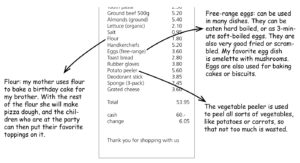- Each student brings a store receipt (Aldi, Costco, Walmart, Publix, etc.) to class and pastes it in the middle of an A3 size paper. Around the receipt, students write as accurately as possible what can be done with the items on the receipt. The items on the receipt and the explanation/description are then connected with an arrow. (Idea from “Language Window“, Topic: writing, page 29).

- The teacher provides each student with an object (i. e. a cloth or a small tin can). The students then describe their objects in writing in as much detail as possible, without, however, naming the object (!), referring to it as “my XY”. The objects are then placed on the left side of the classroom, and the written descriptions on the right. The texts are numbered, the objects labelled with letters. The students then try to correctly match the descriptions to the objects (e. g. 3 = F). See also #7.2b above.
- Variants: describing pictures (postcards, etc.) of different animals (stuffed toys, pictures or the story behind “for sale” or “lost and found” advertisements.
- The instructor or a student repeats 2–3 times a small gesture or action (e. g. taking a book out of a closet). The students try to describe the action in as much detail as possible. Their descriptions are then compared and discussed. Variant (more difficult): two students enact a small scene (i. e. a greeting); the other students describe it in as much detail as possible.
- Let’s imagine that we have to explain to our great grandmother how to use a cell phone or how to use a computer and log on to the internet. In pairs, the students then try to test how useful the descriptions are.






